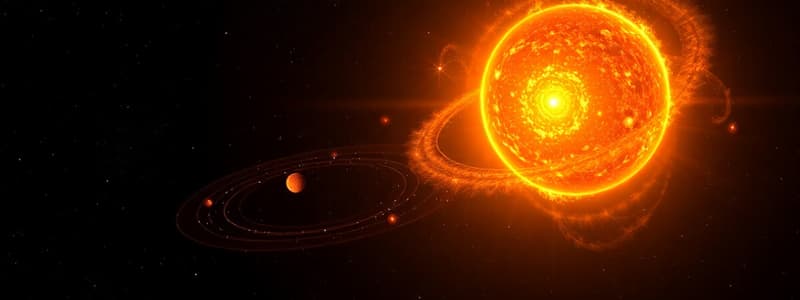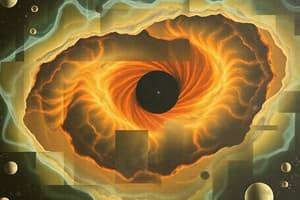Podcast
Questions and Answers
What is the main idea behind the Nebular Hypothesis?
What is the main idea behind the Nebular Hypothesis?
- The planets were formed before the Sun.
- The solar system formed from the collision of other stars.
- The Sun was created independently of its surrounding planets.
- The solar system originated from a giant rotating cloud of gas and dust. (correct)
What evidence supports the Nebular Hypothesis?
What evidence supports the Nebular Hypothesis?
- Records of solar flares emitted by the Sun.
- Ancient photographic records of planetary alignments.
- The distribution of angular momentum in the solar system. (correct)
- Observations of black holes in the galaxy.
Which hypothesis involves encounters between stars and the Sun?
Which hypothesis involves encounters between stars and the Sun?
- Encounters Hypothesis (correct)
- Planetary Migration Hypothesis
- Nebular Hypothesis
- Protoplanet Hypothesis
What does the Protoplanet Hypothesis refine about the formation of the solar system?
What does the Protoplanet Hypothesis refine about the formation of the solar system?
Which of the following best defines planetesimals in the context of the Nebular and Protoplanet Hypotheses?
Which of the following best defines planetesimals in the context of the Nebular and Protoplanet Hypotheses?
What role do protoplanetary disks play in understanding the formation of the solar system?
What role do protoplanetary disks play in understanding the formation of the solar system?
Which hypothesis suggests that matter was drawn from the Sun to create planets?
Which hypothesis suggests that matter was drawn from the Sun to create planets?
What is the ultimate outcome of the processes described in both the Protoplanet and Nebular Hypotheses?
What is the ultimate outcome of the processes described in both the Protoplanet and Nebular Hypotheses?
What was the main goal of the early Mars exploration efforts?
What was the main goal of the early Mars exploration efforts?
What significant finding was presented by NASA regarding Mars in recent studies?
What significant finding was presented by NASA regarding Mars in recent studies?
What was the primary mission of the Rosetta space probe?
What was the primary mission of the Rosetta space probe?
What did the analysis of water ice from comet 67P reveal?
What did the analysis of water ice from comet 67P reveal?
What did the images captured during the New Horizons flyby of Pluto indicate?
What did the images captured during the New Horizons flyby of Pluto indicate?
Flashcards are hidden until you start studying
Study Notes
Origin of the Solar System
- The solar system formed around 4.6 billion years ago from a giant rotating cloud of gas and dust known as the solar nebula.
- Gravity caused the solar nebula to collapse, leading to a spinning disk; the central region formed the Sun, while remaining materials created planets, moons, asteroids, and comets.
- Evidence supporting the Nebular Hypothesis includes observations of protoplanetary disks around young stars and the distribution of angular momentum within our solar system.
Encounter Hypothesis
- Buffon’s encounter (1749) described a sun-comet interaction that ejected matter to form planets.
- James Jeans (1917) proposed a sun-star interaction drawing matter from the Sun to form planets.
- T.C. Chamberlain and F.R. Moulton (1904) suggested a larger star passing near the Sun created gaseous filaments that formed planetesimals.
- Ray Lyttleton (1940) theorized that interactions between companion stars could create proto-planets, eventually leading to Jupiter and Saturn.
Protoplanet Hypothesis
- The Protoplanet Hypothesis refines the Nebular Hypothesis, positing that planets formed through the accumulation of smaller planetesimals in the early solar nebula.
- Planetary differentiation explains the distribution of terrestrial planets near the Sun and gas giants further out.
- This hypothesis aligns with computer simulations of planetary formation processes.
Recent Advancements in Solar System Exploration
-
Mars Exploration: Since the 1960s, unmanned probes have been sent to Mars to assess habitability, with NASA's Viking program achieving a successful landing in 1975. Recent findings indicate seasonal flow of liquid brine water on Mars.
-
Rosetta's Comet Mission: Launched on March 2, 2004, by the European Space Agency, Rosetta aimed to study comets and succeeded in landing the Philae probe on comet 67P/Churyumov–Gerasimenko on November 12, 2014. Findings revealed the comet's water isotopic composition differs from Earth's.
-
Pluto Flyby: On July 14, 2015, NASA's New Horizons provided the first close-up images of Pluto, revealing a complex terrain with ice mountains and vast crater-free plains, indicating recent geological activity over the past 100 million years.
Studying That Suits You
Use AI to generate personalized quizzes and flashcards to suit your learning preferences.




